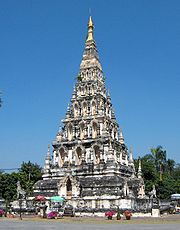
Wiang Kum Kam
Encyclopedia

Ping River
The Ping River , along with the Nan River, is one of the two main contributaries of Chao Phraya River. It originates at Doi Chiang Dao in Chiang Dao district, Chiang Mai Province. After passing Chiang Mai town, it flows though the provinces Lamphun, Tak, and Kamphaeng Phet...
, which was built by King Mangrai as his capital before he moved it to Chiang Mai
Chiang Mai
Chiang Mai sometimes written as "Chiengmai" or "Chiangmai", is the largest and most culturally significant city in northern Thailand. It is the capital of Chiang Mai Province , a former capital of the Kingdom of Lanna and was the tributary Kingdom of Chiang Mai from 1774 until 1939. It is...
. It was flooded and abandoned more than 700 years ago; that move became more understandable in 2005, when the ancient city was flooded three separate times and the river overflowed its banks in that area of Chiang Mai
Chiang Mai
Chiang Mai sometimes written as "Chiengmai" or "Chiangmai", is the largest and most culturally significant city in northern Thailand. It is the capital of Chiang Mai Province , a former capital of the Kingdom of Lanna and was the tributary Kingdom of Chiang Mai from 1774 until 1939. It is...
.
History
Wiang Kum Kam is an ancient city located in Saraphi District in the northern region of ThailandThailand
Thailand , officially the Kingdom of Thailand , formerly known as Siam , is a country located at the centre of the Indochina peninsula and Southeast Asia. It is bordered to the north by Burma and Laos, to the east by Laos and Cambodia, to the south by the Gulf of Thailand and Malaysia, and to the...
, around 30 km (18.6 mi) south of Chiang Mai
Chiang Mai
Chiang Mai sometimes written as "Chiengmai" or "Chiangmai", is the largest and most culturally significant city in northern Thailand. It is the capital of Chiang Mai Province , a former capital of the Kingdom of Lanna and was the tributary Kingdom of Chiang Mai from 1774 until 1939. It is...
. According to the chronicle
Chronicle
Generally a chronicle is a historical account of facts and events ranged in chronological order, as in a time line. Typically, equal weight is given for historically important events and local events, the purpose being the recording of events that occurred, seen from the perspective of the...
s and archaeological evidences, the old city was built by King Mangrai around the latter part of the 13th century
13th century
As a means of recording the passage of time, the 13th century was that century which lasted from 1201 through 1300 in accordance with the Julian calendar in the Christian/Common Era...
.
The city was established as a new capital by the King after his victory over the Mon people
Mon people
The Mon are an ethnic group from Burma , living mostly in Mon State, Bago Division, the Irrawaddy Delta, and along the southern Thai–Burmese border. One of the earliest peoples to reside in Southeast Asia, the Mon were responsible for the spread of Theravada Buddhism in Burma and Thailand...
's kingdom of Hariphunchai, modern Lamphun
Lamphun
Lamphun is a town in northern Thailand, capital of Lamphun Province. It covers the whole tambon Nai Mueang of Mueang Lamphun district...
. Wiang Kum Kam flourished during the reign of the Mangrai dynasty until the late 16th century
16th century
As a means of recording the passage of time, the 16th century lasted from 1501 to 1600. It is regarded by historians as the century in which the rise of the West occurred....
.
The old city was then lost from history for many years after Chiang Mai was conquered by the Burmese in 1558. There is a presumption that it flooded again at this time and was finally abandoned. The people were moved back to this area again more than 200 years later with a new community, and it was then named Chang Kham village (.)
In 1984, the Department of Fine Arts Unit 4 discovered remnants of the old city around Wihan
Vihara
Vihara is the Sanskrit and Pali term for a Buddhist monastery. It originally meant "a secluded place in which to walk", and referred to "dwellings" or "refuges" used by wandering monks during the rainy season....
Kam Thom at Wat Chang Kham and afterwards excavation was begun; since then many new remains have been found and restoration has proceeded since that time.
The main temple of the town is Wat Chedi Liam (originally: Wat Ku Kham), which is still occupied by monks.

